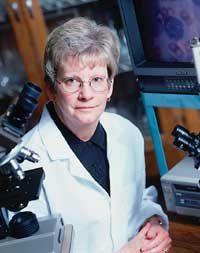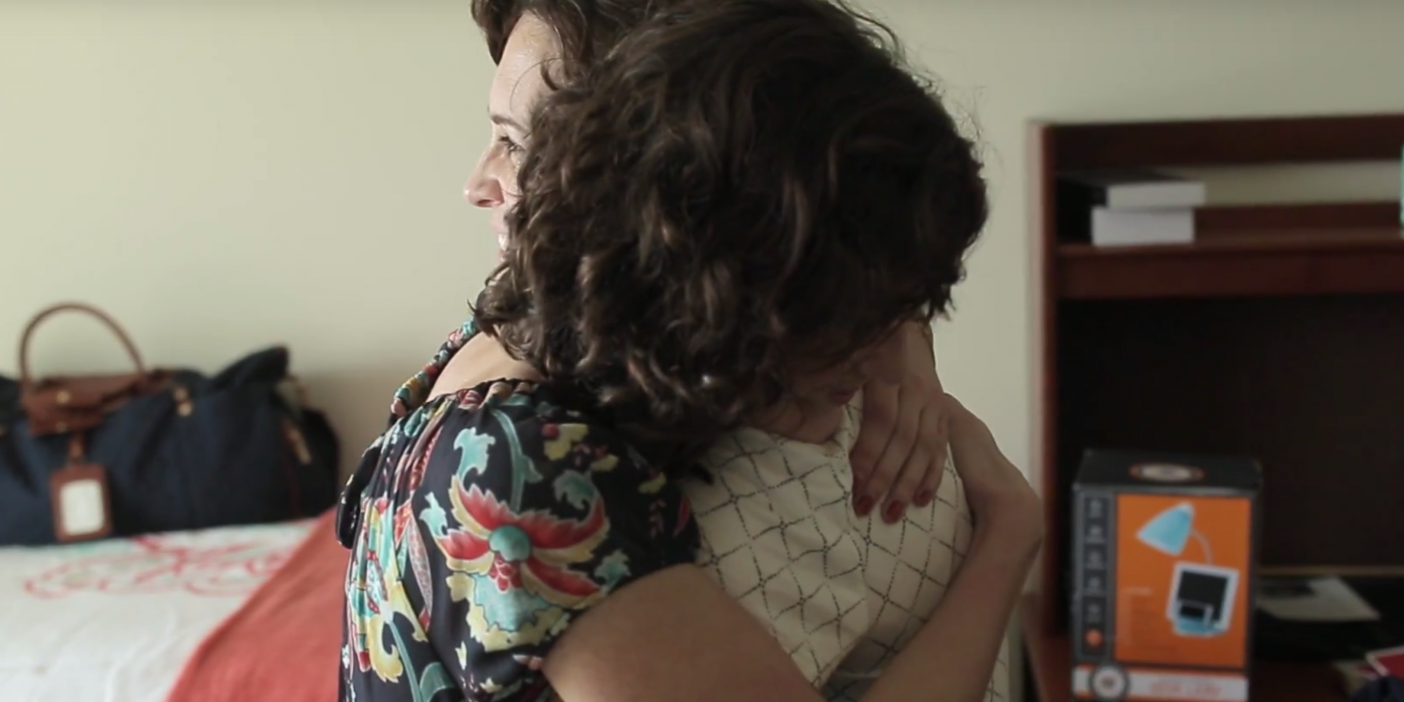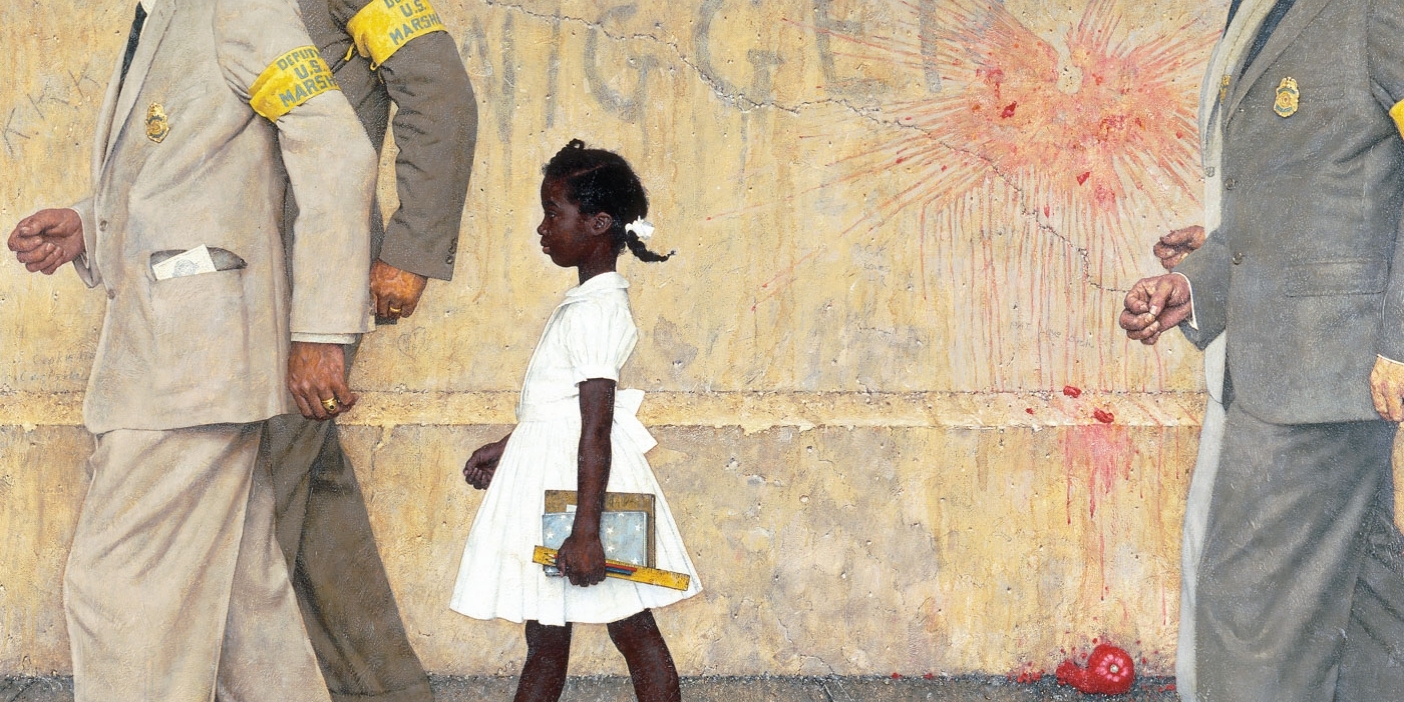
Since founding BYU’s clinical laboratory sciences program 26 years ago, Professor Shauna C. Anderson has collected blood slides, wacky costumes, and a national reputation for curricular excellence.
Shauna Anderson has been known to come to class carrying a huge lollipop, a fishing rod, a flyswatter, even an old rifle. Most often, though, she simply brings doughnuts or blood. That would be boxes of bonafide, bakery-made doughnuts—and glass microscope slides with dyed blood cells representing various disease conditions. Her students quickly learn to appreciate both kinds of gifts.
Of course it’s not hard for BYU students to appreciate treats on a test day. As for the blood films, “She really prepares you well for what you’re going to do in the hospital,” says B. Kent Anderson, a senior from Blackfoot, Idaho. In BYU‘s clinical laboratory sciences (CLS) program, students learn how to perform and interpret the laboratory tests hospitals use to assess patient health and diagnose disease.
Medical laboratories have fascinated Professor Shauna Anderson since she was in high school. “Somehow I found a book on hematology,” she explains, “and I knew that’s what I wanted to do.” Since founding BYU‘s program in 1974, she has taught clinical chemistry, hematology, and other courses to students headed for work in hospital labs. Her enthusiastic teaching and contributions to her field have made her one of the best-known CLS educators in the nation.
By her own account, Anderson runs a rigorous program. “The students don’t really know what’s going to be demanded when they get out into the field and start practicing,” she explains. After completing just two semesters of specialized course work on campus, her students apply their skills in six-month internships at local hospitals. “We always tell them we don’t want them to kill somebody in a hospital,” she says. “We want them to be the very best, and we push them.”
“If we weren’t up to where she expected, she would tell us,” says Lindsay Orton Robison, an Orem, Utah, native who finished her hospital internship in July 2000. “We had a lot to learn.”
Though her expectations are high, Anderson tries to balance academic strictness with humor and warmth. As the only full-time faculty for a program that can admit only 12 students each semester, she and colleague Susan Cockayne, an associate teaching professor, know their students well. And even when their courses are most difficult, “We try to make them as tolerable as we can,” Anderson says.
For example, “Fridays are test days for her classes,” says Lonnie W. Riggs, a former Microbiology Department secretary who now works in the dean’s office for BYU‘s College of Biology and Agriculture. “So she always brings doughnuts to class on Friday to help with the thought process.” Success in simultaneously supporting and challenging students was part of the reason Anderson received one of BYU‘s 1997 Karl G. Maeser Excellence in Teaching Awards.
“You get used to being in those huge classes where you’re afraid to talk to the professors,” says senior Kent Anderson. “But Shauna was always easy to approach, and I always felt like she was willing to explain something.” Anderson (no relation to his professor) will complete his hospital rotation and graduate in December 2000. Two of his older brothers are also alums of BYU‘s clinical laboratory sciences program.
One favorite tradition that has developed in the program is a game-like annual review session. On the last day of the hematology course, Anderson and Cockayne—often assisted by the department office staff—don costumes representing various diseases. Students then guess their identities by asking questions a practitioner would ask in diagnosing each disease.
To suggest “hairy cell” leukemia, for example, one of the professors wears the furry lining from a coat and a pair of hair-embellished gloves. To suggest aplastic anemia, one of them enters swathed in a huge sheet of clear plastic. A rifle, flyswatter, fishing rod, and lollipop are props for other ensembles. Through visits to thrift stores, Anderson and Cockayne have collected a repertoire of about 30 wacky costumes.
Advancing the Field
Hired in 1974, Anderson was the first female faculty member in BYU‘s microbiology department, and she added color right away. The 1974 faculty photo for the College of Biology and Agriculture shows her standing in the back row among her microbiology colleagues—blonde and diminutive, wearing a white lab coat and a wildly patterned blouse.
“I was the first one in the building that initiated having curtains,” she says, reasoning that if she was going to spend so many hours in her office, it ought to be homelike. In 1997, when she became the first woman named as Microbiology Department chair, she promptly hung curtains in the department office, too.
That improve-your-environment approach has been a hallmark of Anderson’s career. While teaching has always been her focus, she has also published research about lipids, specifically cholesterol and apolipoprotein levels in women. “We’re just trying to find the best tests for the best health care,” she says. In the last 10 years, however, she has focused on developing curricular products and advancing her field at the national level.
Wanting a textbook that met their needs, Anderson and Cockayne wrote a clinical chemistry text, first published in 1993, which they are now revising for its second edition. But the project Anderson is most proud of is a CD-ROM atlas for teaching hematology. “What we’ve done is show the fastest and most efficient way to make the diagnosis through the laboratory,” she explains.
Created by Anderson and Cockayne in collaboration with BYU adjunct clinical instructor Keila Poulson and former adjunct clinical instructor Sarah Dawson, the CD-ROM includes 100 case studies. The product won the 1997 Scientific Creativity Award from the American Society for Clinical Laboratory Sciences (ASCLS).
Anderson and Poulson are currently preparing an expanded second edition of the CD-ROM with an accompanying manual. Like the first edition, their new materials will be published by Lippincott Williams & Wilkins, a leading international publisher of professional health information.
At the national level, Anderson has long been involved in accreditation procedures for clinical laboratory science programs, and in September 2000 she will begin a four-year term on the national accrediting agency’s board of directors. Olive M. Kimball, executive director of the National Accrediting Agency for Clinical Laboratory Sciences, says that Anderson’s accreditation work “has had a tremendous impact on the quality that programs are able to attain.”
But perhaps Anderson’s greatest professional contribution has been her work in updating her field’s “body of knowledge”—the corpus of information all qualified practitioners are expected to master. The body of knowledge reference document is widely used in CLS programs for curricular decisions, accreditation measures, and certification exams, and Anderson chaired the task force that revised it. For her leadership in that role, she received the 1998 Robin H. Mendelson Memorial Award, theASCLS‘s highest award.
“She has been a steady and creative force in the education arena of our organization for a long time,” says James T. Griffith, the 1999-2000 president of ASCLS and chancellor professor of medical laboratory science at the University of Massachusetts. “Her reputation is very solid as being a doer, an accomplisher, a person who actually moves the field forward.”
Outside the Lab
Her colleagues at BYU describe Anderson as a woman who is constantly moving forward in several fields. “She doesn’t procrastinate,” Cockayne says. “She just jumps in immediately and gets it done.” Though she loves the laboratory, Anderson has interests as diverse as the items she brings to class.
While growing up in the tiny town of Teton, Idaho, Anderson learned how to maintain a yard. “My mom and dad had a big garden,” she recalls. “And the way I made money—because I didn’t want to babysit—was to mow most of the widow ladies’ lawns, and they’d pay me a dollar a lawn.”
Today Anderson has “a yard you cannot believe,” Riggs says. “During the spring and summer months she always made sure I had a fresh flower on my desk.” Anderson’s widowed mother, age 88, now lives with her, and they design the yard together. They have twice won Provo City beautification awards for their work.
Genealogy is another pursuit she inherited from her mother. Anderson has long displayed a big pedigree chart in her campus office, but her genealogy interest intensified when she uncovered the route her immigrant grandmother had taken from Sweden to Utah. During the past several years she and colleagues Ruth Maness of the LDS Family History Department and BYU Church history and doctrine professor Susan Easton Black have put together a book making the names of 14,000 Scandinavian immigrants accessible to researchers. Volume two of their project will contain biographical notes about 520 missionaries who served in Scandinavia during the 1800s.
Along with its curtains, plants, and genealogy chart, Anderson’s office high in the Widtsoe Building holds other evidence of her interests. Two of her shelves are dedicated to the rare books and antique medical equipment she collects, and a bowling trophy stands on the window sill.
Anderson has always loved sports. “When I grew up Church softball was a big thing,” she says, and at BYU in the mid-1960s, “I think I played everything here—basketball and field hockey and softball.” After graduating she played six seasons of semiprofessional softball with the Utah Shamrocks.
Anderson quit the Shamrocks around the time she was hired at BYU, but she stayed involved in softball, first on a series of community teams and then—when the league went to slow-pitch and the aggressive third-base woman found herself impatient at the plate—as coach of a slow-pitch team. She now competes on a local bowling team “because you can be elderly and bowl,” she says with a laugh. “I sponsor a team, and so our name is ‘Lipid Ladies.'”









